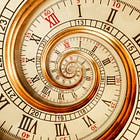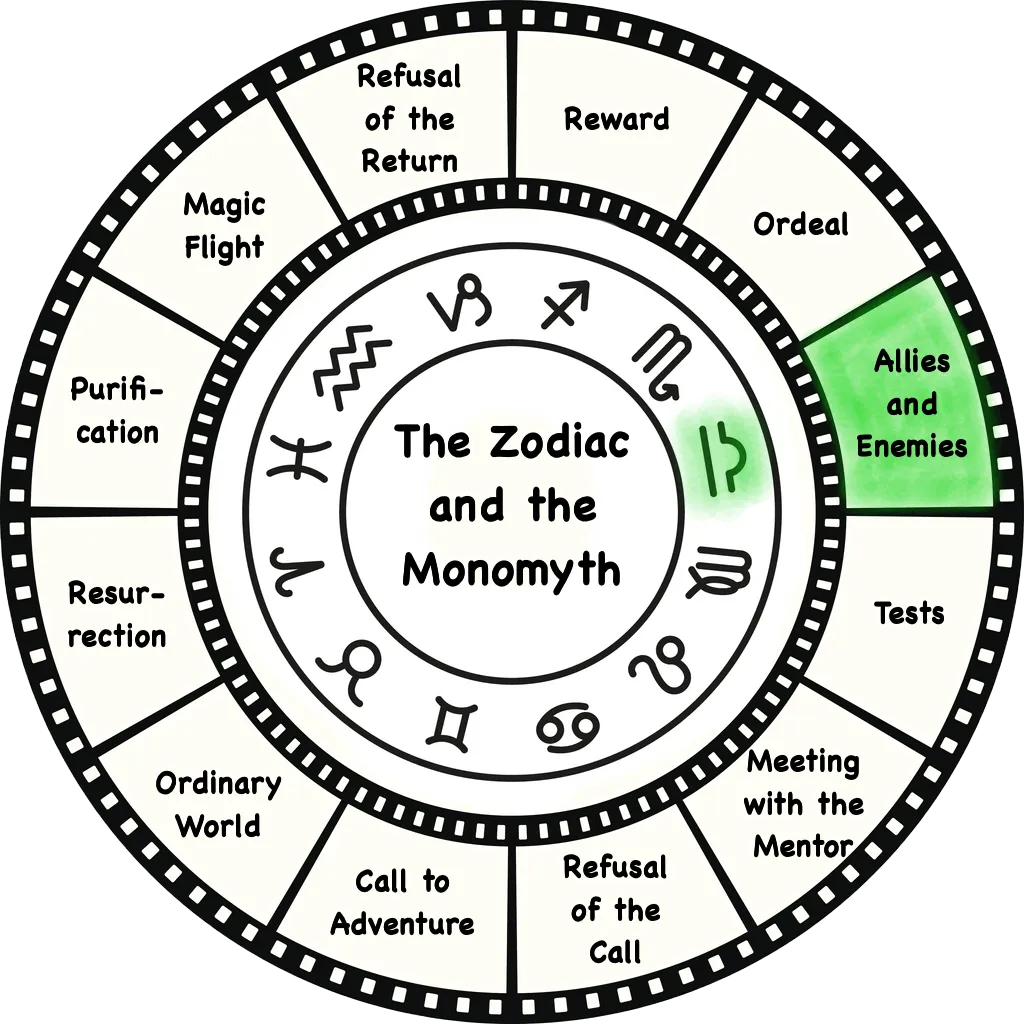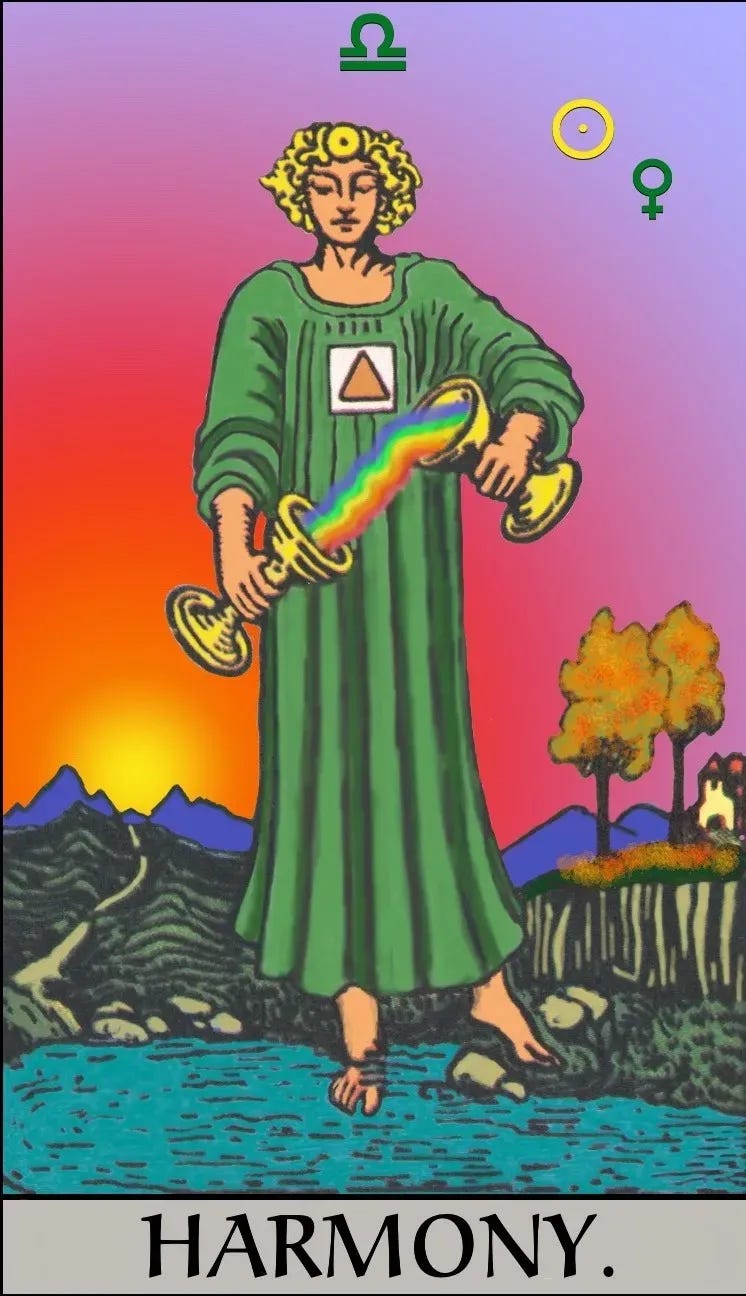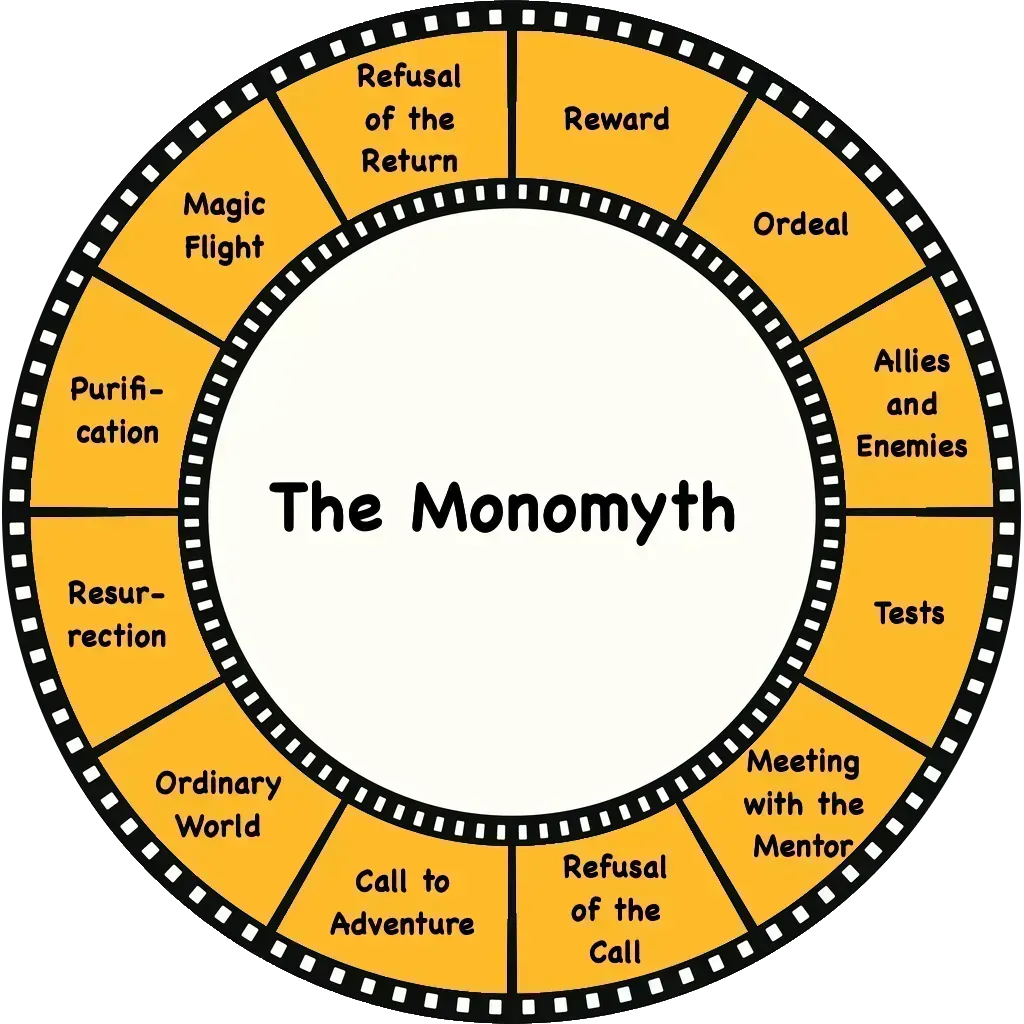Quest for the Elixir: The Happiness of Harmony
Allies and Enemies, Libra, and Harmony (Temperance)
Quest for the Elixir
This post is part of an ongoing series. If you’re new to it, you’ll want to read the introduction first (about 6 minutes):


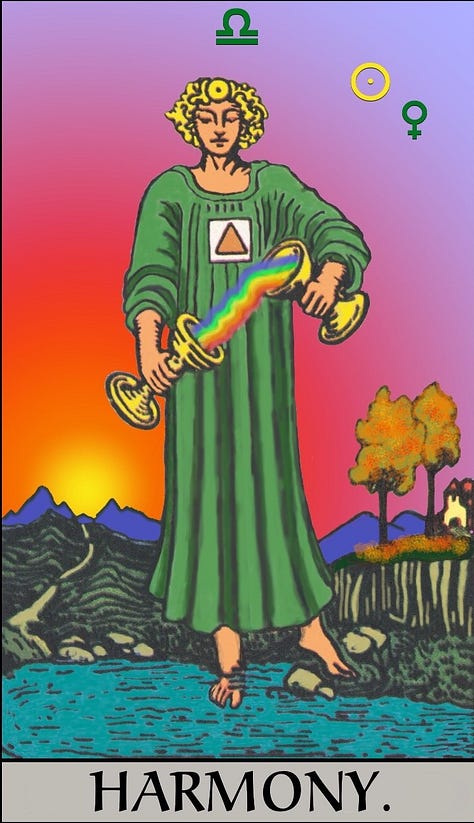
Three Articles About a Chapter of the Universal Story
Each edition of Quest for the Elixir consists of three articles about one of the 12 chapters in the cyclical Universal Story.
The first article is an exploration of the chapter from the perspective of the Hero’s Journey in Joseph Campbell’s monomyth.
The second article is a view of the same chapter in terms of the Zodiac sign corresponding to it in the cycle.
The third article is about the meaning of the chapter as symbolized in a Major Arcana card of the tarot.
During the month of the Sun’s transit through Libra, we observe the chapter of The Happiness of Harmony in the Universal Story. In celebration, I offer the following three articles:
The Monomyth: Allies and Enemies
"Everyone you meet knows something you don't know but need to know. Learn from them." — Carl Jung
While his skills were being tested on The Road of Trials, the hero of the monomyth has had opportunities to observe the behavior of other inhabitants of the Special World, to learn from them and about them. This present stage of reflection on relationships marks a transition of general mental focus from external to internal, a turning inward.
The stress of challenging situations exposes deeper layers of everyone’s personal character. By now the hero is in a position to evaluate the way he relates to the others around him, and to distinguish those who qualify as “allies” from those to be distrusted as “enemies”. Who seems trustworthy? Who is likely to work against him? With whom can he cooperate well?
“Whether you call someone a hero or a monster is all relative to where the focus of your consciousness may be.” ― Joseph Campbell, The Power of Myth
As the hero experiences relationships in the monomyth, so do we all experience them in real life — and the real ones are more complex. Because life involves change and growth, learning who we all are is really an endless process. As we discover qualities and attitudes in others, we also discover them in ourselves. These discoveries prompt changes in everyone from time to time, so that we are all continuously learning and changing. Sometimes people turn out not to be who we thought they were or who they had previously thought they were, and we can discover that we have changed or have even been misunderstanding ourselves. At any given time in our story, we can only use our best judgment and keep on learning. Time eventually shows how wise or foolish our evaluations are.
"One is always in the dark about one's own personality. One needs others to get to know oneself." — Carl Jung
We are often unaware of traits in ourselves that we can easily recognize in other people. While observing another person, we may feel unusually impressed somehow by what we see, and ask ourselves, Do I do that? or Could I do that? We’ve projected an unconscious trait of our own on someone else who apparently carries it. It’s been brought to our attention so that we can begin to work with it consciously.
It’s always something that needs development. A strong positive reaction to what we see reflected in another could hint at an unrecognized aptitude that we could develop into a personal talent if we tried. A negative one could indicate a problem in need of correction.
“Gods suppressed become devils, and often it is these devils whom we first encounter when we turn inward.” ― Joseph Campbell
A strong negative reaction to another person could be a reflection of some natural energy in ourselves that we’re neglecting and unknowingly expressing in childish, primitive, stupid ways. Usually we’re reluctant to know about that, and growing more uncomfortable the longer we avoid the issue. But our unconscious is eager to enlighten us, often through our experiences with other people. When it does, we may realize that with some effort we could cultivate our crudely-expressed energy into more mature, refined, wise, and beneficial forms of expression.
So we meet and interact with other people, and coincidentally with our inner selves. Many of our connections with others are brief and superficial; others are deeper, with more of a sense of rapport (or antagonism), and some of those evolve into relationships of various types that may or may not be long lasting.
Our relationship with another person is a blend of energies with qualities of its own and some degree of transformational power.
"The meeting of two personalities is like the contact of two chemical substances: if there is any reaction, both are transformed." — Carl Jung
"The greater the contrast, the greater the potential. Great energy only comes from a correspondingly great tension of opposites." — Carl Jung
In a relationship, the natural ‘chemistry’ between two people is experienced by both of them, and their awareness and choices contribute to its qualities. Some relationships are stronger than others; there are special ones within which the rapport is unusually powerful.
"As soon as the dialogue between two people touches on something fundamental, essential, numinous, and a certain rapport is felt, it gives rise to a phenomenon which Lévy-Bruhl fittingly called participation mystique. It is an unconscious identity in which two individual psychic spheres interpenetrate to such a degree that it is impossible to say what belongs to whom." — Carl Jung
Such a powerfully positive state of rapport is found in marriage as described by Joseph Campbell.
“Marriage is not a love affair. A love affair is a totally different thing. A marriage is a commitment to that which you are. That person is literally your other half. And you and the other are one. A love affair isn't that. That is a relationship for pleasure, and when it gets to be unpleasurable, it's off. But a marriage is a life commitment, and a life commitment means the prime concern of your life. If marriage is not the prime concern, you're not married....The Puritans called marriage "the little church within the Church." In marriage, every day you love, and every day you forgive. It is an ongoing sacrament – love and forgiveness.... Like the yin/yang symbol....Here I am, and here she is, and here we are. Now when I have to make a sacrifice, I'm not sacrificing to her, I'm sacrificing to the relationship. Resentment against the other one is wrongly placed. Life in in the relationship, that's where your life now is. That's what a marriage is – whereas, in a love affair, you have two lives in a more or less successful relationship to each other for a certain length of time, as long as it seems agreeable.”
― Joseph Campbell, The Power of Myth
Conversely, at the opposite extreme there is a powerfully negative state of antagonism in what is known as the Shadow.
"Everyone carries a shadow, and the less it is embodied in the individual's conscious life, the blacker and denser it is. At all counts, it forms an unconscious snag, thwarting our most well-meant intentions." — Carl Jung
"A man's hatred is always concentrated upon that which makes him conscious of his bad qualities." — Carl Jung
Our unrecognized shadow is a part of our feelings and belongs to us. But it isn’t a mere subtle hint at a weak energy that we might choose to cultivate, or a dislike with a rational basis. It’s irrational, extreme, “larger than life”, numinous (‘magically’ charged), and not in a good way. It’s a terrifying threat from an unknown natural energy so repulsive and unacceptable to us that it hides as a twisted, toxic, enraged ‘monster’ in the deepest, darkest pit of our unconscious. It’s our Greatest Enemy and our Deepest Fear. We feel we’d rather die than have anything to do with it, much less ask ourselves if we might own it. When we encounter our projection of it on someone else, that person becomes the target of our most irrational and most intense hatred. What’s more, that “horrible, evil” target can seem to multiply.
"Projection [of our own shadow] makes the whole world a replica of our own unknown face." — Carl Jung
“It is in the nature of political bodies always to see the evil in the opposite group, just as the individual has an ineradicable tendency to get rid of everything he does not know and does not want to know about himself by foisting it off on somebody else. Nothing has a more diverse and alienating effect upon society than this moral complacency and lack of responsibility, and nothing promotes understanding and rapprochement more than the mutual withdrawal of projections." — Carl Jung
We need to own and withdraw our projections, but we can’t do that if we’re not seeing them for what they are. So as we continue to deny them, they continue to haunt us, and things get worse. Not only does this thing of horror seem to be everywhere, but in its desperation for our attention, it eventually takes over our own personality in a sort of “possession”.
"You always become the thing you fight the most." — Carl Jung
Everyone has a shadow. Our ego, which rightfully promotes a positive self-image, would love to claim total perfection and blame all of its weaknesses on other people. But that never works. Whether we like it or not, our own portions of the life energies are ours to develop, and ours alone. Attempts to run away from the necessary challenges we dread most will backfire on us repeatedly until we face them.
"The Shadow is a moral problem that challenges the whole ego-personality, for no one can become conscious of the shadow without considerable moral effort. To become conscious of it involves recognizing the dark aspects of the personality as present and real. This act is the essential condition for any kind of self-knowledge, and it therefore, as a rule, meets with considerable resistance. Indeed, self-knowledge as a psychotherapeutic measure frequently requires much painstaking work extending over a long period of time." — Carl Jung
Like the hero of the monomyth, each of us has a threatening shadow that we’d prefer to escape. It’s ugly and hurtful, and we want everything to just stay as pleasant and nice as we want to believe it is. But our shadow doesn’t let us escape, and that’s for a reason. Our very sanity depends on our owning and dealing with our own poisonous inner negativity. So another person who serves as the hated object of our shadow projection is actually doing us a favor by bringing it to our attention.
"Conflict exists strictly as an opportunity to raise our consciousness." — Carl Jung
"To confront a person with their own shadow is to show them their own light." — Carl Jung
It’s not that the target of our irrational hatred is necessarily innocent of wrongdoing. Maybe he is; maybe not. But that’s a separate issue. Regardless of external facts and their ramifications, for the sake of our own well-being we need to heed our cue to look within ourselves. If we see the irony in the way we’ve been our own worst enemy, we can convert our negative inner “devil” into a positive inner “angel” and save ourselves and others from unnecessary misery.
“Love thine enemies because they are the instruments of your destiny.” ― Joseph Campbell, The Power of Myth
We may run for a while, but we and our shadow can only hide for so long. If we continue to neglect the issue, eventually we’ll confront it anyway in a showdown, and we’ll pay a painful price for what we still haven’t learned.
Allies and Enemies in The Wizard of Oz
In our Wizard of Oz example of this stage of the monomyth, Dorothy gets along very well with the inhabitants of Oz she meets on the Yellow Brick Road. This clip and the next show the harmonious rapport among the companions as they start “off to see the Wizard” together. We see clearly how beautifully the characters relate to one another. Declarations of loyalty and friendship confirm that they are allies, while an appearance of the wicked Witch of the West leaves no doubt that she is an enemy.
Wanna Play Ball?
We’re Off to See the Wizard
There are other allusions to harmony and beauty in this part of the story. We hear the sweet, harmonious singing of “Optimistic Voices” as the companions dash happily through a temptingly pleasant field of poppies to the gates of the Emerald City.
You’re Out of the Woods (“Optimistic Voices”)
Once in the City, the companions are graciously welcomed and treated to a tour of its beauties. Then they are taken to a salon where attendants and beauticians refresh and beautify each of them.
In the Merry Old Land of Oz
But even in the midst of this pleasant and hopeful scene, the evil Witch of the West appears again with another threat. She’s still around and not about to leave Dorothy in peace.
Surrender Dorothy
Libra
Libra is one of the three Air signs, all of which reflect modes of thinking. Unlike the other two Air signs (creative Aquarius and logical, analytical Gemini), Libra thinks contextually, i.e., in terms of circumstances and relationships of components to one another. Libra lends itself to harmony in the arts and among people, to social cooperation in general.
All of the Air signs are sociable, but in different ways. Whereas Gemini’s main social interest is exchange of information, and that of Aquarius is creative collaboration, Libra focuses on one-to-one encounters and relationships between equals. Valuing the individuality of any other person, Libra strives for consideration, fairness, and cooperation to please both people equally.
The Libran style is charming, gracious and pleasant, ready to adapt for the sake of cooperation and peace as long as others seem to be doing likewise. Beauty and harmony are wherever Libra is. But unkindness and discord are very offensive to Libra, who simply withdraws in response to them rather than react with retaliation.
In an astrological chart, houses represent the various ‘departments’ of life, and the places where they function. The natural house of Libra is the 7th house, located in the right part of the wheel as shown above. That’s the house of partnership (of any kind — business, marriage, best friends, etc. — basically “the other”), and the sign on its cusp in a natal chart describes our general attitude to relationship and qualities we need in a partner.
In the language of astrology, planets function as ‘nouns’ or ‘verbs’ that represent or express the various energies of life. Each sign reflects the qualities of the planet which rules it. The ruler of Libra is Venus of beauty, which is also the ruler of Taurus. Whereas the beauty of Venus in Earthy Taurus is mainly physical, in Airy Libra it’s more interpersonal and social.
Venus is always charming and sweet, but not always with a positive motive. In positive expression, the motive is the honest pleasure of a sweet and tasteful experience for, and preferably with, appreciative people. A negative expression may involve a hidden motive, insincerity, or “beauty” degraded to tastelessness.
Harmony (Temperance)
Between a cliff and a long road, a peaceful-looking, green-robed figure stands with one foot on the earth and the other in a pool of water. On the forehead of the figure is a Sun glyph, and on his breast is an upright triangle (Fire) within a square (Earth). He is holding a golden cup in either hand, pouring a multicolored liquid from one cup to the other.
Near the edge of the cliff there is a house and some trees whose leaves are changing color, some having already fallen to the ground. The house with its lawn looks earthy and familiar, but autumn is upon it, and the nearby cliff edge hints at an ending there.
The long road leads through the valley and upward into the mountains, behind which the Sun is setting. To follow the road will be to follow where the Sun is now going, through the valley, then upward and far away from the earth, over the horizon and thence below to another, inner world.
Everything in this bittersweet scene suggests an in-between moment of transition. The summer season is dying, the day is dying, and the figure in fertile green is dying likewise. All are going to rest. Life is retreating naturally from a sunny ‘day’ in the physical world into the starry ‘night’ of the spiritual world.
The Sun glyph on the figure’s forehead connects the figure mentally with the Sun. Fire within Earth over the figure’s heart symbolizes the “underworld home” where the Sun will be spending the night/winter when the earth and his body are frozen in death.
Feet are symbols of the soul; one of the figure’s feet is still on the earth (embodied); the other is being washed clean in the water (free of earth/the physical body, dissolving into death).
Cups are symbols of the Water element as containers of feelings and memories. The metal that corresponds to Cups is silver, but these two are of gold, the metal of the Sun. Perhaps they would hold feelings that are more genuine and sincere than the superficial passing moods and fantasies so often carried in the silver Cups of the Moon.
The water flowing between the two Cups is like the rapport between two souls, flowing alternately from one to the other, charged with multicolored energies in their own unique blend. It appears that the Solar figure holding the Cups will see a smooth flow between them, and equal portions in each, in this final meeting before he sets out on the long journey through the valley and over the mountain. That done, all that go to rest can rest in peace.
In divination, I read Harmony (Temperance) as someone who is cooperating well with another (or others) in his situation and promoting harmony there.
If it’s reversed, I read it as someone who is failing to cooperate or is in a situation with an uncooperative other (or others), or who has no one with whom to cooperate.
The Libra Files
More to enjoy whenever the Sun is in Libra
Quest for the Elixir
Continue to the next chapter:



